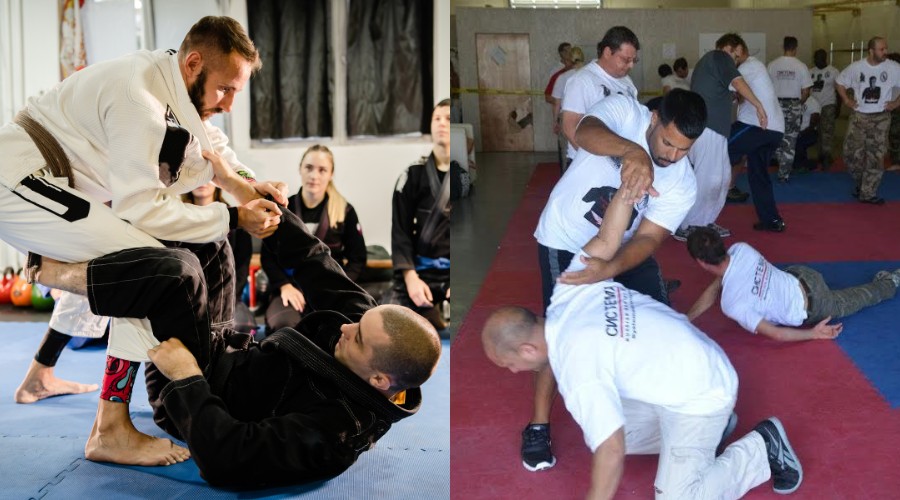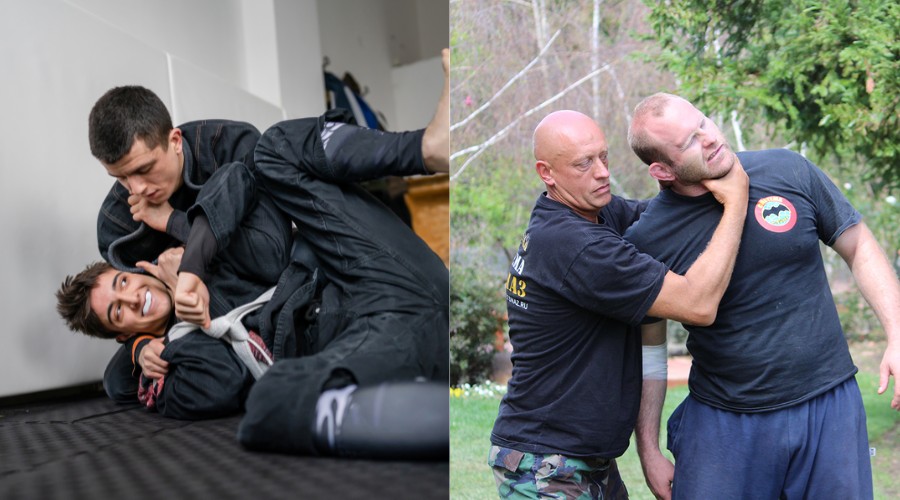Finding a more controversial and universally regarded fake martial art than Systema is difficult. The weird training, too fluid and flexible movements, and incredibly unrealistic demonstrations have not earned the Russian style a good name in the martial arts community. Is there any point in comparing it to BJJ, which is proven to be an effective fighting style?
On most levels, BJJ is far better than Systema because it uses a training methodology that results in skills applicable against real-life resisting opponents. Systema’s training style teaches valuable body mechanics but no fundamental fighting skills, which makes it not very good on its own, at least as a fighting style.
Still, there is a surprising amount of value if you are willing to look past Systema’s surface nonsense, and it may even be beneficial for BJJ practitioners. Don’t believe me? Find out what makes me believe Systema is not all bad and how this relates to jiu-jitsu.
What Is BJJ
Brazilian jiu-jitsu is a martial art and combat sport from Brazil focusing on ground grappling. The style is known for its methodical ground fighting and immense repertoire of positions and submissions used to dominate opponents regardless of size.
Brazilian jiu-jitsu began as Judo in the early 1920s when a Japanese judoka named Mitsyo Maeda traveled to Brazil to fight and teach students.
Two brothers named Carlos and Helio Gracie became his most important pupils from a historical perspective, as they started focusing more on ground fighting instead of throws and takedowns and gradually created a unique style and school.
BJJ was heavily influenced by catch wrestling and was morphed by challenges in Vale Tudo fights, but in time, a grappling-only aspect began gaining more popularity.
The style blew up in popularity with the advent of the UFC and modern MMA, and people realized the power of grappling in a real fight.
Today, BJJ is one of the most widely practiced martial arts and is an ever-growing combat sport on the cusp of gaining mainstream popularity amongst combat sports fans.
What Is Systema
Systema is a Russian martial arts system for self-defense and self-development emphasizing complete relaxation instead of muscle tension, intuitiveness, breathing, and structure.
The system, which is the martial art’s name, as systema in Russian means system, has its roots in the Russian tradition from the Middle Ages and was used by the Speznaz special forces during the USSR period.
The modern schools that teach civilians and popularized the style were created in the early 1990s, after the dissolution of the USSR.
A few schools of Systema exist, but the most popular worldwide is Systema Vasilev, named after Vladimir Vasilev, who opened the first school outside of Russia when he moved to Canada in 1993.
The central figure responsible for the initial spreading of Systema outside of the military is Mikhail Ryabko, regarded as the grandmaster of the whole system.
Systema is designed to be a complete set of concepts and training components that enhance one’s life. This includes physical, mental, and spiritual development. The two main principles are relaxation and breathing.
Relaxation, essential for success in any combat scenario, assists fighters in maintaining a clear mind while managing stress.
Breathing, an important aspect of Systema, allows fighters to sustain energy levels and focus. Structure and movement, combined with relaxation and breathing, produce a fluid fighting style adaptable to various situations.
Key Differences Between BJJ and Systema

Key Features
Key Features Of BJJ
- Focuses almost entirely on ground fighting through the use of superior positioning and submission holds
- BJJ is trained as a sport and for self-defense
- Sports BJJ is the most popular version and is grappling only with no striking allowed.
- There is a well-developed competitive scene all across the world
- Traditional BJJ with the gi has a progression system and uses colored belts to denote the rank of the wearer
- It has two distinct versions- gi and no-gi
Key Features Of Systema
- It is a self-defense system with no sports element and no competitions
- Systema is a set of principles and exercises rather than a structured system of techniques
- The main emphasis is relaxation and breathing integrated into instinctive movements used for combat
- There are a few different schools of Systema, with slightly different teaching methods
Techniques
BJJ deals almost entirely with ground fighting, and all the techniques are used with ground domination in mind. Positioning is an essential concept in BJJ, and the recommended approach is methodical, where you first obtain a dominant position of control and then apply a submission.
Common positions in BJJ are the mount, side control, back control, and many different guard positions, which allow you to defend and attack effectively while on your back.
In traditional BJJ, some striking is used to close the distance, but in sports, jiu-jitsu striking is not allowed and is not part of the training, except in self-defense classes.
Systema does not have a set of moves and techniques. Since there are no rules to abide by and the main principle is effortless movement, all strikes, defensive movements, and grappling techniques are fluid, intuitive, and adaptable to all kinds of situations.
Training
Of all the martial arts styles, or at least the ones with some degree of popularity, no other system utilizes training that looks as random as Systema.
Because the key principle is relaxation, much of the training revolves around learning how to stay as relaxed as possible in many situations.
Unfortunately for the public image of Systema, many of the exercises look like pointless rolling on the floor and many other peculiar-looking sequences.
Many movements are also excessively exaggerated when drilling, but they are intended to be used more realistically. This is the same principle used in Karate kihon and kata: you train with big movements to grasp the complete mechanics but use only the final part of the movement in reality.
Since it’s a self-defense system, Systema also does training with weapons, mainly knives. In addition to the many movement and strengthening exercises, there is a lot of partner drilling.
Similarly to traditional martial arts, this is done with a complying partner and no resistance most of the time.
Brazilian jiu-jitsu is much more structured in its training, and the purpose is more singular: obtaining and mastering the techniques and principles of jiu-jitsu and using them against fully resisting opponents.
Training consists of warm-ups, drills of techniques and sequences with a partner, and free or situational sparring called rolling, a crucial part of BJJ training and the most critical element making the style so effective.
BJJ vs Systema For MMA

By now, you are probably well aware of how effective BJJ is for mixed martial arts. While the days of pure BJJ guys dominating were short-lived, jiu-jitsu is one of the main pillars of MMA and something every single fighter must train in and have some level of competency in, so BJJ is without a shadow of a doubt the better style for MMA.
But is Systema completely useless for mixed martial arts? Probably not.
Regardless of how ridiculous and fake Systema looks, the biomechanics taught in it are sound, and being able to relax and tense in the right moments is taught in karate, boxing, BJJ, and pretty much every other style. But with Systema, the concept is taken to an extreme level.
Nevertheless, relaxation and fluidity are things every MMA fighter can benefit from.
Systema also offers some unconventional strikes and angles, which, if integrated into an already solid fighting style, can be effective and catch many opponents off guard.
So, in general, Systema on its own is most likely as useless for MMA as you think it is, but for someone who already has a solid base and knows how to fight, it can introduce some new and unorthodox but effective principles. The following two videos show how people with a wealth of MMA experience can find value in Systema.
BJJ vs. Systema For Self-Defense
For the most part, and most practitioners, BJJ is much better for self-defense. After you gain some experience on the mats, the nature of BJJ training means you will inevitably be able to control and submit the vast majority of the untrained population.
Yes, there are gaps in BJJ for self-defense, like the absence of striking, the weak takedown game, and the fact that going to the ground in a street fight is generally bad.
But regardless of this, BJJ does teach you fighting skills, which you learn to apply against fully resisting people from day one.
In my opinion, sparring and pressure testing are the most important elements in every martial art and the only way to learn how to fight.
Systema is designed for self-defense, but most training does not facilitate that. While you will learn how to be relaxed, condition your body physically, and probably gain some mental control without sparring, it’s hard to execute in a high-stress situation when you are not used to the feeling.
I know Systema punches and strikes are hard because I have personal experience with a few people who have trained in the style.
The mechanics of complete relaxation and tension at the precise moment lie at the foundation of all good striking, so Systema strikes can be devastating.
But can you deliver them in a situation where the opponent is already anticipating an attack and is in “fight mode”? I don’t believe so.
Perhaps the highest-level masters can apply their skills in real combative situations or against MMA fighters, but 95% of practitioners can’t, while every BJJ practitioner with more than a year of training can tie most of the general population in a knot.
As you can see in the video by Sense Seth, Systema principles can be applied to a preexisting skillset. And as the coach in the video also stresses, you must be honest about it. If you want to be able to strike and wrestle with people, you have to spar, and there is no way around it.
Can Systema Be Beneficial for BJJ?
Since most of the audience of this site is made up of Brazilian jiu-jitsu practitioners, a logical question is whether or not Systema has some benefit for BJJ.
Being fluid and relaxed is crucial for BJJ, especially if you want to endure long rolling rounds. Breathing is another still relatively underexplored area in BJJ.
Although Rickson Gracie and others stress the importance of breathing control and exercise, most people have only surface knowledge of the topic.
Systema’s expertise is precise control over one’s body, relaxation, and breathing, which is why cross-training may help your BJJ game.
Like in the previous paragraphs, I have found elite-level practitioners who say Systema can help other martial arts, in this case, Brazilian jiu-jitsu, so perhaps there is some truth in it.
BJJ vs Systema: Which Is Better?
For me, BJJ is infinitely better than Systema. It has proven to be one of the most effective grappling styles, and the immense growth in popularity speaks volumes about its many qualities.
If you train BJJ, you will learn how to grapple effectively, be a part of a large community, learn practical self-defense skills, and have tons of fun. Even detractors of the style do not argue against these arguments.
Systema, on the other hand, is controversial. Training is strange. There are a lot of fake schools and even more dishonesty about what it is and what it isn’t. In my opinion, training Systema on its own makes no sense if you want to learn how to fight and defend yourself.
But if you already have some background in jiu-jitsu or other martial arts and want to learn principles you can apply and enhance your skills, then Systema can be worth exploring.
